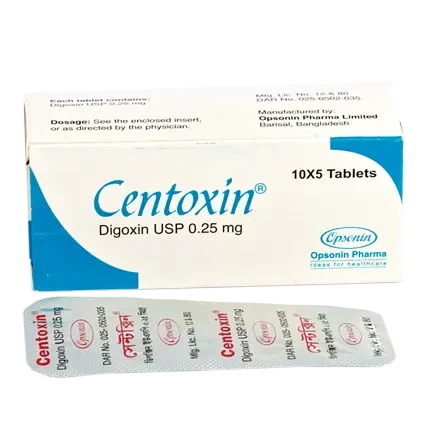Unit Price:
৳ 1.09
(5 x 10: ৳ 54.50)
Strip Price:
৳ 10.90
Also available as:
Indications
Centoxin is indicated in:
- Heart failure.
- Atrial fibrillation with an uncontrolled ventricular rate.
- Acute left ventricular failure.
- Chronic left ventricular failure and conjestive heart failure, especially when caused by hypertensive valvular (especially mitral valvular) disease or ischaemic heart disease.
Pharmacology
Digoxin is a cardiac glycoside used in the management of particularly atrial fibrillation and in heart failure.The principal actions of digoxin are an increase in the force of myocardial contraction (positive inotropic activity and a reduction in the conductivity of the heart particularly in conduction through the atrioventricular node. Digoxin also has a direct action on vascular smooth muscle and indirect effects mediated primarily by the autonomic nervous system and particularly by an increase in vagal activity.
Dosage & Administration
By oral administration:
- Rapid digitalization: 1-1.5 mg in divided doses over 24 hours
- Less urgent digitalization: 250-500 micrograms daily (higher dose may be divided)
- Maintenance: 62.5-500 micrograms daily (higher dose may be divided) according to renal function and in atrial fibrillation on heart rate response.
- Usual range: 125-250 micrograms daily (lower dose may be divided) according to renal function and in atrial fibrilation on heart rate response.
- Usual range: 125-250 micrograms daily (lower dose may be appropriate in the elderly).
Interaction
Potassium-depleting diuretics increase the effects of digitalis. Calcium particularly if administered rapidly by the intravenous route, may produce serious arrhythmia in digitalized patients. Quinidine, verapamil, amiodarone, propafenone, indomethacin, itraconazole, alprazolam, spironolactone, erythromycin, clarithromycin (and possibly other macrolide antibiotics) and tetracycline increase Centoxin serum level. Besides antacids, kaolinpectin, sulfasalazine, neomycin, penicillamine, calestipol, metoclopramide, rifampin may interfere with intestinal absorption of Centoxin resulting low serum concentrations of the drug.
Contraindications
- Ventricular fibrillation.
- Hypersensitivity to digoxin or other digitalis preparation.
Side Effects
Usually associated with excessive dosage include anorexia, nausea, vomiting, diarrhoea, abdominal pain, visual disturbance, headache, fatigue, drowsiness, confusion, delirium, hallucination, depression, arrhythmia, heart block, intestinal ischaemia, gynaecomastia on long term use, thrombocytopenia reported. Centoxin can be safely used in pregnancy
Pregnancy & Lactation
Digoxin is excreted in breast milk but in concentration below those found in plasma and therefore poses no hazard to the breast-fed infant.
Use in Special Populations
Neonates: Centoxin can be used in neonates.
Children: Centoxin can be used in children.
The elderly: Partly because of reduced renal function and partly because their tissues are more sensitive to the effects of digitalis, the elderly require a lower maintenance dose of Centoxin than younger adults.
Children: Centoxin can be used in children.
The elderly: Partly because of reduced renal function and partly because their tissues are more sensitive to the effects of digitalis, the elderly require a lower maintenance dose of Centoxin than younger adults.
Therapeutic Class
Positive Inotropic drugs
Storage Conditions
Store in a cool and dry place.Keep out of the reach of children.


